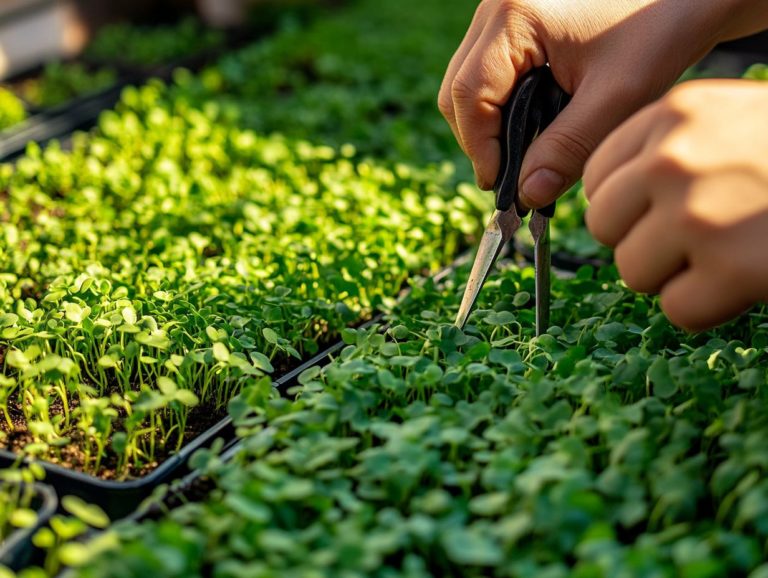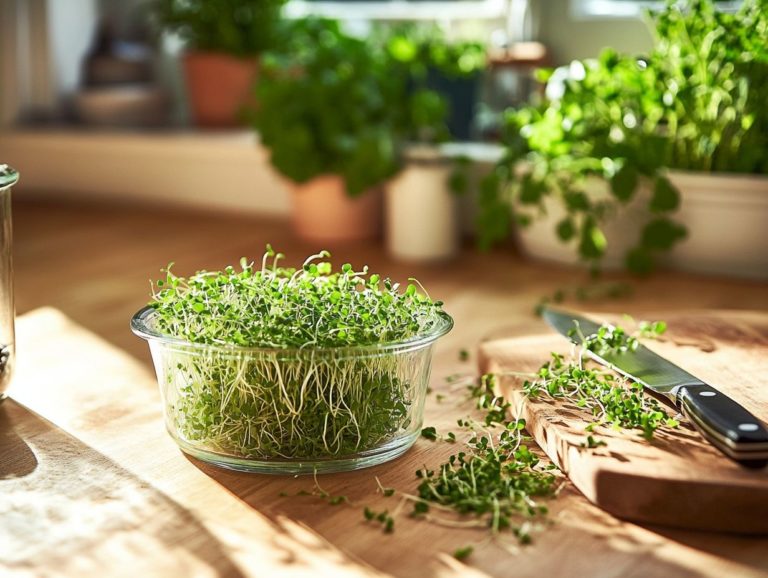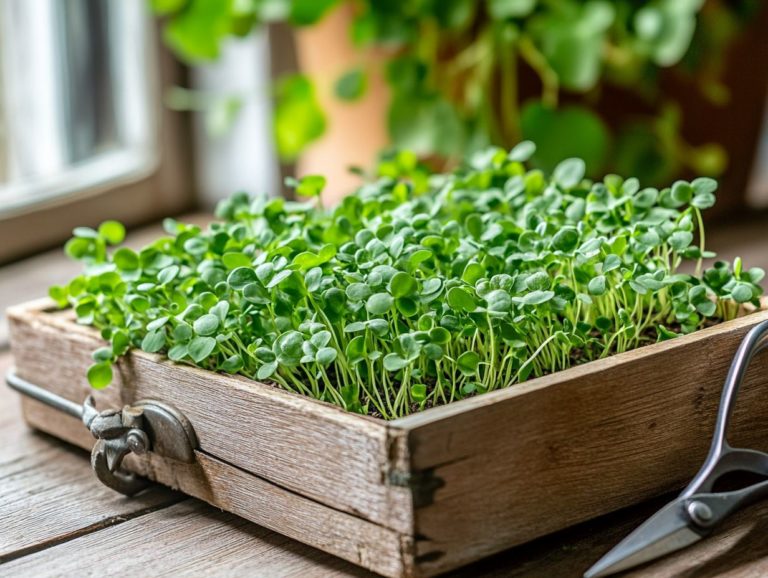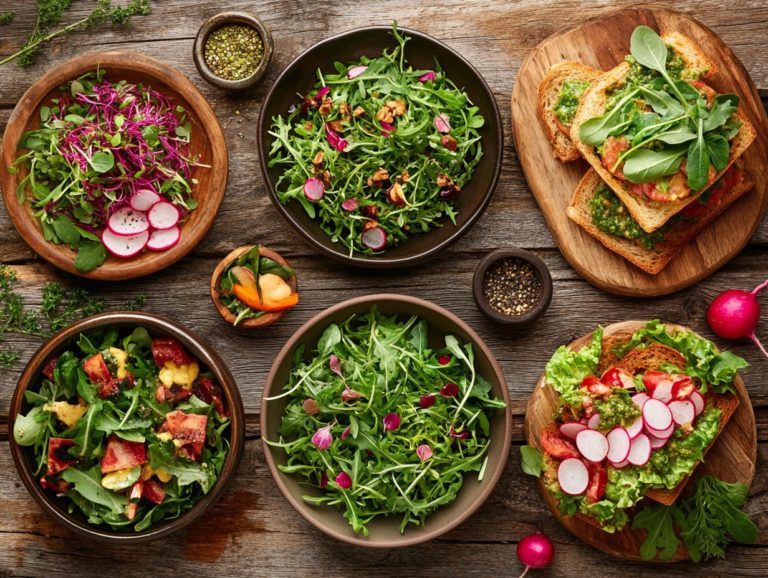Microgreens in Summer: Harvesting and Storage Tips
Microgreens are those tiny, nutrient-rich plants that can truly elevate your summer meals and enhance your gardening experience.
In this article, you ll explore the numerous benefits of growing microgreens during the summer months, from their rapid growth to their vibrant flavors. You ll learn the best harvesting techniques to guarantee optimal freshness and discover effective storage methods to keep your greens crisp and ready to use.
You ll also discover creative recipes that will inspire you to incorporate these delightful greens into your summer dishes. Prepare to transform your culinary creations and savor the abundant flavors of summer!
Contents
- Key Takeaways:
- Benefits of Growing Microgreens in Summer
- Harvesting Microgreens
- Storing Microgreens
- Creative Ways to Use Microgreens
- Frequently Asked Questions
- 1. What are microgreens and why are they popular in summer?
- 2. How do I know when my microgreens are ready to be harvested?
- 3. What is the best way to harvest microgreens in summer?
- 4. Can I store harvested microgreens in the fridge?
- 5. How can I prolong the shelf life of my microgreens?
- 6. Can I freeze microgreens for later use?
Key Takeaways:

- Summer is the ideal time to grow microgreens, as they thrive in warm weather and can be harvested within 1-2 weeks.
- Harvest microgreens when they are 1-2 inches tall using clean scissors, and store them in a sealed container in the fridge for up to a week.
- Microgreens are a versatile addition to summer meals, adding flavor, texture, and nutrition. Try them in salads, sandwiches, smoothies, and more!
What are Microgreens?
Microgreens are young, edible plants that you can harvest just after their first true leaves emerge. They offer an impressive variety of flavors, colors, and textures. These tiny greens come from various plant families, each delivering unique flavors that can elevate everything from your salads to your sandwiches.
Rich in vitamins and antioxidants, microgreens boast numerous health benefits, making them a favorite among those who prioritize nutrition in their diets.
Beyond their culinary charm, these greens are lauded for their outstanding nutrient density, delivering up to 40 times more nutrients than their mature counterparts. Their vibrant colors and delicate textures make them the perfect addition to your meals, providing a healthful boost that supports overall wellness and encourages a balanced diet filled with fresh ingredients.
Benefits of Growing Microgreens in Summer
Growing microgreens during the summer months offers a wealth of advantages, making it an ideal time whether you’re a novice or a seasoned gardener. The warm weather and extended daylight create optimal conditions that enhance both the flavors and the nutritional density of your fresh microgreens.
Summer varieties flourish, allowing you to experiment with a diverse range of microgreens. This season promotes sustainable practices, making it easier for community-supported agriculture initiatives to thrive by providing customers with fresh, organic seeds. For more information on how to care for your harvest, check out these tips for washing and storing microgreens.
Why Summer is the Perfect Time for Microgreens
Summer is often seen as the perfect season for growing microgreens, thanks to the warm temperatures and abundant sunlight that create an ideal environment for robust growth. You ll find that these conditions significantly enhance the nutrient density and overall flavor profile of various microgreen types.
During the summer, the consistent warmth supports quicker germination and growth rates, allowing you to cultivate microgreens in as little as one to two weeks. The increased sunlight not only boosts photosynthesis but also elevates the levels of vitamins and antioxidants, transforming these greens into true powerhouses of nutrition. For optimal freshness, check out these storing microgreens tips.
If you’re new to gardening, the forgiving nature of microgreens means that even with minimal experience, you can successfully nurture your garden. Don’t miss out on growing your own microgreens this summer! Enjoy a bountiful harvest while reaping the health benefits of consuming fresh, nutrient-rich greens. After you harvest, be sure to check out what to do with microgreens to make the most of your crop.
Harvesting Microgreens
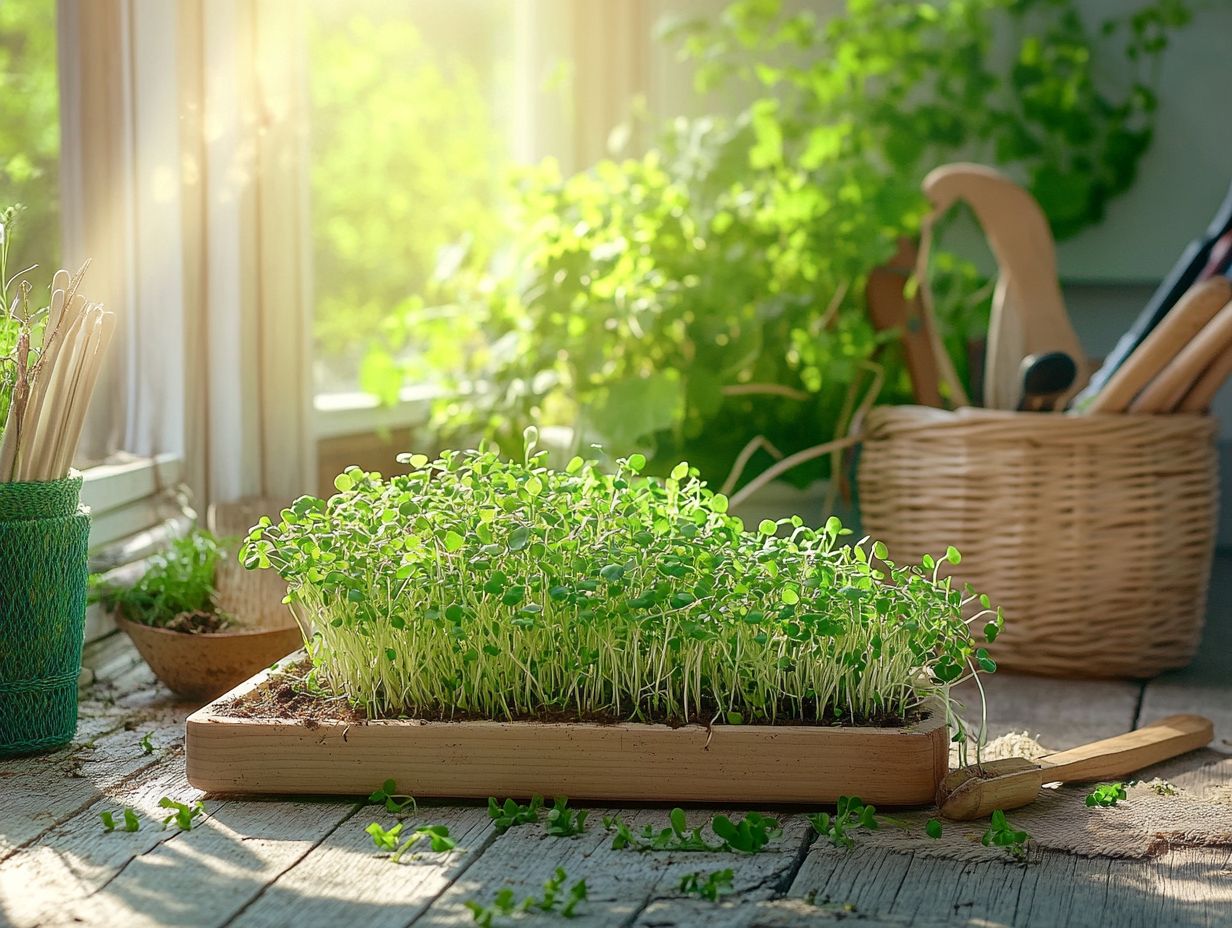
Harvesting microgreens is a crucial phase in the growing process that greatly impacts their flavor, texture, and overall quality. Knowing when and how to harvest these delicate greens allows you to relish their peak health benefits, flavor, and nutritional value.
While the types of microgreens may vary, the underlying principle is consistent: getting the timing and method right is essential for yielding tender, fresh microgreens that make for delightful salad toppings or elegant garnishes. To ensure optimal freshness, it’s important to know the best storage temperature for microgreens.
When to Harvest
Understanding when to harvest microgreens is vital for maximizing their nutrient density, flavor, and shelf life. Harvest them when they reach a height of 1 to 3 inches, depending on the specific variety you re cultivating.
Timing is everything; harvesting too early can stunt their growth, while waiting too long can diminish their flavor and crispness. Pay attention to color and leaf development to identify the perfect moment for picking. Vibrant greens often signify optimal nutrient content, while the emergence of true leaves indicates they are ready for harvest. For those looking to maximize freshness, consider the best microgreens to grow for storage.
Certain varieties, like radish and mustard microgreens, deliver their best flavor just before they fully mature usually around 10 to 14 days after planting. On the other hand, crops like peas might take longer, generally ranging from 14 to 21 days.
By keeping a close watch on these indicators, you can ensure your microgreens retain their robust flavors and impressive nutrient profiles.
Proper Techniques for Harvesting
Using the right techniques for harvesting microgreens is essential to preserving their delicate structure and ensuring they deliver their finest flavor. Reach for a clean, sharp pair of scissors or a knife to cut the microgreens just above the soil line, being careful to minimize damage to the remaining plant.
This careful method enhances the quality of your fresh microgreens. It also promotes further growth if you plan to harvest more times. Consider the specific type of microgreens you’re working with, as some varieties may require a gentler touch than others. For instance, tender varieties like baby basil need a delicate hand, while sturdier options like radish greens can withstand a bit more force. For more information, explore the best methods for storing microgreens.
Cleanliness is equally important; always ensure your tools are sanitized to prevent contamination, which could compromise the freshness and flavor of your microgreens. For tips on maintaining their quality, check out how to keep them crisp and fresh. By following these guidelines, you can enjoy a bountiful and flavorful yield from your home garden.
Storing Microgreens
Storing microgreens correctly is crucial for preserving their freshness, flavor, and nutritional value post-harvest. Due to their delicate nature, microgreens come with a relatively short shelf life, making effective storage techniques critical.
Ensure the right moisture balance by placing them in airtight containers or using paper towels to absorb excess moisture. These methods can significantly extend their viability and allow you to enjoy their benefits for a longer time.
Tips for Keeping Microgreens Fresh

To keep your microgreens fresh for as long as possible, store them in an airtight container to minimize exposure to air, which can cause wilting. Managing humidity levels is key; placing a damp paper towel in the container helps regulate moisture and keeps your greens crisp and vibrant.
If you prefer using plastic bags, seal them tightly but take care not to crush those delicate microgreens. For optimal freshness, refer to storing microgreens in the refrigerator as some varieties like basil and cilantro have their own humidity preferences; for example, basil thrives in a low-humidity environment.
Storing your microgreens in the vegetable drawer of your fridge is a wise choice, as this area usually maintains slightly higher humidity levels. Additionally, for those looking to grow microgreens successfully during colder months, consider these tips for growing microgreens in winter. Also, resist the urge to wash them until you’re ready to enjoy, as excess water can lead to spoilage.
Best Storage Methods for Summer
During the summer months, proper storage methods for microgreens are essential. Higher temperatures can accelerate spoilage. To keep your microgreens fresh, store them in the refrigerator at a cool temperature ideally at or below 40 F.
Consider using vacuum sealing to enhance shelf life and maintain the vibrant flavors of your microgreens.
Incorporating humidity control can also help retain their crispness and nutritional value. Opt for containers with breathable lids to allow optimal air circulation while reducing moisture buildup, which can lead to wilting.
If you live in hot climates, investing in temperature-controlled storage options or using cool packs can provide extra protection against the heat. Avoid washing microgreens before storage; excess moisture fosters spoilage. Instead, rinse them just before consumption for maximum freshness.
By following these techniques, you ll extend the lifespan of your microgreens and enhance their taste, ensuring they remain a delightful addition to your summer meals.
Creative Ways to Use Microgreens
Incorporating microgreens into your meals can elevate both flavor and nutrition, making them a versatile addition to many dishes.
These delightful greens can serve as salad toppings, garnishes, or even be blended into smoothies for an extra health boost.
Their unique flavors and vibrant colors not only enhance the visual appeal of your meals but also encourage healthful eating habits, turning every dining experience into a feast for the senses.
Recipes and Ideas for Incorporating Microgreens into Summer Meals
Adding microgreens to your summer meals is a great way to infuse fresh flavors and health benefits into your dining experience. Imagine tossing a mix of microgreens into a refreshing salad, where their vivid colors and textures beautifully complement seasonal fruits and vegetables.
Consider using microgreens as a nutritious topping for grilled meats or fish, enhancing flavor and presentation.
Blend microgreens into your smoothies for a nutrient boost that keeps the taste light and refreshing. If you enjoy experimenting in the kitchen, try adding microgreens to sandwiches or wraps this simple addition can elevate an ordinary meal to gourmet status. They can also enhance flavorful dips, contributing texture and a punch of vitamins.
By integrating these tiny greens into various dishes, you enhance both the aesthetic appeal and nutritional value of your meals, transforming them into wholesome and enjoyable experiences.
Frequently Asked Questions
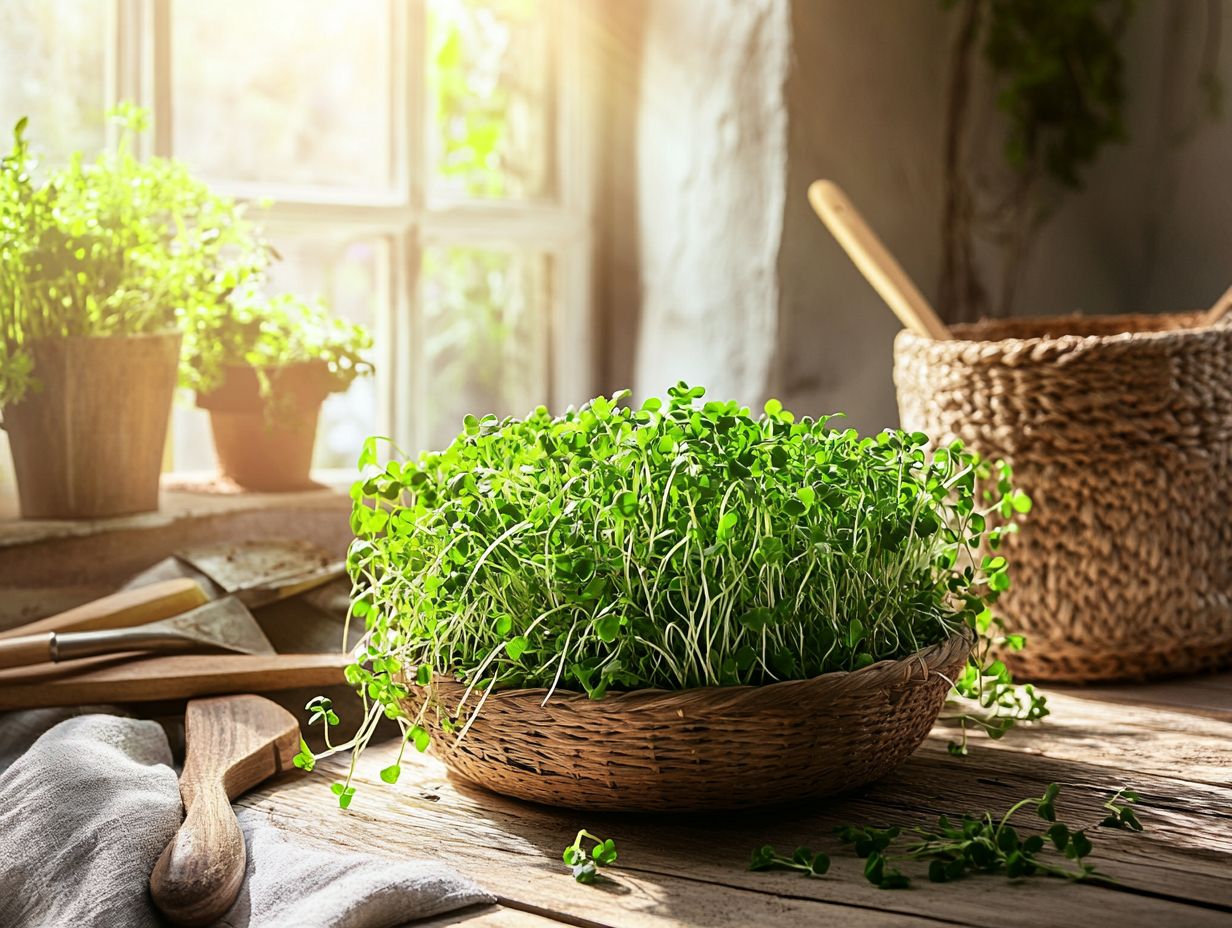
1. What are microgreens and why are they popular in summer?
Microgreens are tiny, edible greens harvested just a few weeks after germination. They are popular in summer because they are easy to grow, require minimal space, and are packed with nutrients and flavor.
2. How do I know when my microgreens are ready to be harvested?
Microgreens are typically ready to be harvested when they develop their first set of true leaves, usually within 7-14 days after germination. Check their height; they should be around 2-3 inches tall.
3. What is the best way to harvest microgreens in summer?
The best way to harvest microgreens is to use clean scissors or a sharp knife to cut the greens just above the soil line. This prevents damage to the delicate roots, allowing you to continue harvesting from the same tray.
4. Can I store harvested microgreens in the fridge?
Yes, harvested microgreens can be stored in the fridge for up to a week. For maximum freshness, wrap the greens in a paper towel and place them in an airtight container or ziplock bag. Remove any excess moisture before storing.
Try these tips and recipes to make the most of your microgreens this summer!
5. How can I prolong the shelf life of my microgreens?
To keep your microgreens fresh for longer, harvest them at the right time.
Store them correctly in the fridge and wash only before you eat.
Avoid direct sunlight and hot temperatures. These conditions can make microgreens wilt and spoil quickly.
6. Can I freeze microgreens for later use?
Yes, you can freeze microgreens! However, freezing may change their texture and flavor.
For the best results, use frozen microgreens in cooked dishes rather than raw ones.
To freeze, wash and pat them dry.
Place the microgreens in an airtight container or freezer bag, and they ll be good for up to three months!

